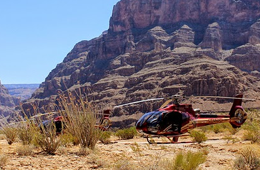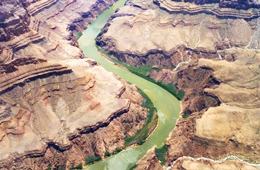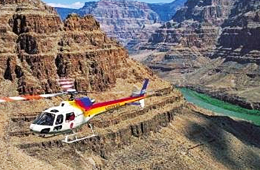If you find yourself in a desert survival situation while hiking or camping in the Grand Canyon, here are a few simple tips about clothing, water and shelter that might just save your life.
It may look beautiful and packed with tourists, the Grand Canyon is still smack dab in middle of the desert. It gets very hot in the day and cold at night, just as you would expect in a desert.
While traveling through the Grand Canyon, you may find yourself experiencing heat-related illnesses, injuries, water shortages, and other types of outdoor dangers.
Deep within the Grand Canyon, there are no roads, no running water, no stores, and no basic infrastructures. This can be avoided with a guided Grand Canyon tour, but if you should find yourself in a bad situation, we hope to arm you with the information necessary.
Knowledge is power.
Boning up on desert survival skills can save your life.
Temperatures in the Grand Canyon

In most desert climates, the day time temperatures have the ability to soar well over 100°F!
In the evening hours, the temperatures have the ability to plummet to the 40s, or even colder!
Based on this information, one fact is true, if the heat does not detrimentally impact you during the day, the rapid influx of cold weather in the evening and night hours might get you.
One step you can take for preparation is to check the weather before you head out the the Grand Canyon. National Park Service posts their Weather and Road conditions online. If its not listed, they’re just a phone call away.
An ounce of prevention is worth a pound of cure. Why not plan your trip according to favorable weather and make sure it’s enjoyable all around.
Some general information about the weather in the Grand Canyon:
- The climate between the rims of the Grand Canyon and the inner area of the canyon varies significantly – depending on the change of the elevation.
- The South Rim is over 1300 meters higher than the Colorado River. As a result, the inner canyon is approximately 15°F degrees to 30°F warmer.
- The North Rim is over 300 meters higher than the South Rim. As a result, the temperature is even warmer in the inner canyon than in the North Rim.
- In the summer, the temperatures in the inner canyon are considered to be extreme.
- Summer temperatures in the South Rim range from 50°F to up to 80°F.
- Because the North Rim is situated at such a high elevation, the area is always the coolest in and around the Grand Canyon.
- Weather conditions may become severe at any time. You must determine which severe weather conditions you may potentially face during the time of the year that you plan on visiting, before visiting.
What to Pack for your Desert Trip

Clothing is meant to protect us. We can be smart about the things we pack to save our skin from harsh climates.
As you know, a desert climate means that the weather will most likely make extreme changes. Warm days and cold nights, right? And of course there’s that occasional rainstorm.
Make sure to pack a lightweight waterproof jacket. It would be smart to also bring an umbrella and a change of clothing.
Should you get wet, you can change your clothes as soon as the conditions dry. You can also use the umbrella to shade yourself during the day.
Don’t forget your sunscreen and a hat with a big brim to shade your face. In hot weather people typically wear sleeveless shirts and shorts.
Face, shoulders, chest and calves are the first things to burn from the sun. You might also bring a light scarf or shirts that cover your shoulders and chest. Sun blisters are awful and can be avoided. Even though it’s hot, pants or long shorts that cover your calves might help.
In the winter, the weather is cold but the sun is still bright and can burn. Wear a hat and use your sunscreen.
In winter, it’s important to dress in layers and bring gloves. The worst thing you can do in cold weather is to sweat. If you’re hiking or working and find yourself starting to sweat, stop and cool off. If your clothes get wet and you don’t have a change of clothing, you will get very cold.
And remember, it is always important to wear the proper footwear.
Read on, and find out why to pack a flashlight, a blanket and a cooking pot.
Finding Water in the Desert
Drink Water! For desert survival, the rule of thumb is to consume a gallon of water a day.
Not only will this amount help to ensure that you are properly hydrated, but it will also ward off the development of heat-related illnesses, such as heat stroke.
Heat stroke can creep up on you. You may not feel very hot or thirsty. This is typical right before heat exhaustion kicks in. Heat exhaustion can make you very sick. You will be out of commission and will need to find a place to cool your body down. Apply cool wet cloths to the neck, back, armpits and groin. If you are near a lake or water source, submerge yourself in the water. Chills are typical when cooling off too quickly.
To prevent heat related illnesses, monitor your urine. Dark urine means you need more water.
One of the worst things that you can do is sip water. Instead, take long slow drinks. Any water that you have at your disposal should be drank in such a way that it hydrates all of your internal organs. Small sips of the liquid will not do this.
If you don’t have a water source, you’ll need to know how to find one in the desert. Naturally, the absolute best sources for fresh water will be springs, streams, and even waterfalls.

Unfortunately, these are far, few, and in-between.
In some instances, you may find it impossible to find these water sources. You may stumble across a lake, but, when in the desert, lakes typically have a high level of salt. If you drink from these sources, first learn about distilling water.
 This will remove the salt.
This will remove the salt.
Simply take a metal container and fill it up with the water.
Then, take large rocks and place them in a fire. Once they are hot, take the rocks and put them into the salt water until the water boils.
Then, cover the container with a cloth so that the vapor absorbs. When the cloth becomes saturated, ring it out into your mouth or into a bottle.
The water that comes from the cloth will be distilled and may be consumed.

You may also collect drinking water through dew. Use rocks, leaves, and any other type of product to collect dew early in the morning. There are cactus plants in the desert that contain water. Unfortunately, many of these plants have a high amount of oxalic acid.
There are fruits on cactus plants that also contain water. If you have an interest in learning how to use cactus plants are food and water sources, it is crucial to obtain training from a true desert survival specialist.
These specialists will know which cactus plants you may eat and drink from and may also be able to educate you on other plants that may be able to provide you with hydration while attempting to survive in the Grand Canyon
Creating a Desert Survival Shelter

1903 wigwam
It’s known that the desert is often too hot to travel during the day. People who live in Arizona find their seasons switched. They stay inside during the summer and enjoy the rest of the year outside.
If you brought a flashlight or lamp, it is best to do your traveling at night – when it is cool. However, you must be especially cautious of the wildlife, treacherous terrain, and other dangers that may be present in the night time hours.
Once the first light of day starts shining through, focus on building your shelter. Basically, your shelter will consist of sticks, some brush, and any type of tarp, sheeting, or cloth that you may have that will provide relief from the rays of the sun.
When traveling the Grand Canyon, also pack emergency blankets. You can use these on your shelter to reflect the sun’s rays off of the shelter – which will provide a lower temperature.
When building a shelter, make certain you do it on a hill. In case of a surprise rainfall, you don’t want to be under water. Flooding has been known to occurin the Grand Canyon.
In order to make the task easier, opt for hills that include outcroppings, sturdy ledges, and/or boulders that aid in the creation of a natural type of wall. Always be aware of your surroundings and keep an eye out for insects and snakes that could be potentially harmful. If you are in an area that is immensely warm, take the following steps to create a shelter:
- First, look for an area in the ground that is shallow.
- Next, dig out a space where you may lay in the ground.
- The sand or dirt that you have pulled out should be placed all the way around the hole/trench that you have created.
- Then, take four sticks and place them around the hole. Immediately thereafter, use these sticks to put up your protective covering.
- Leave a bit of space to optimize air flow. Then, place sticks and your second roof with the emergency space blanket, sheet, or other cloth that you have. This will help reduce the heat and intensity of the sun.
Now that you know about the temperatures that may be experienced in and around the Grand Canyon, know what to wear, know where to obtain water, understand that it is important to learn about the edible plants in the national park, and have learned how to build a desert shelter, you are ready to survive in the desert!



